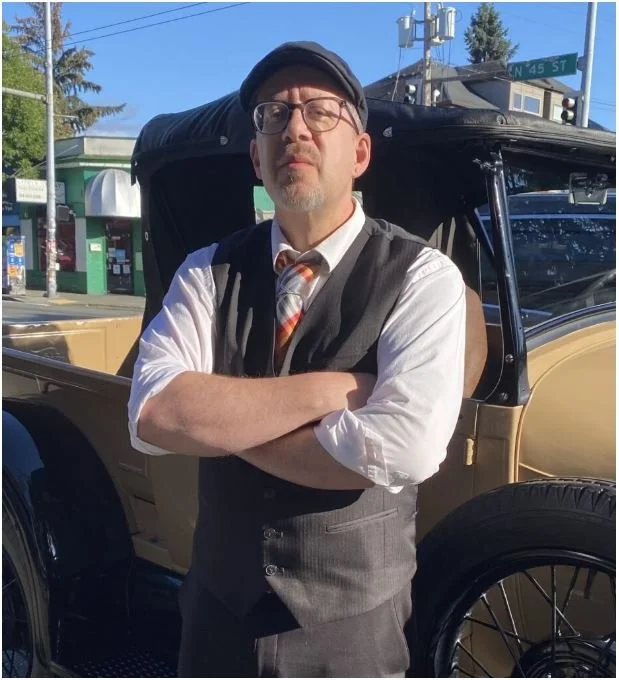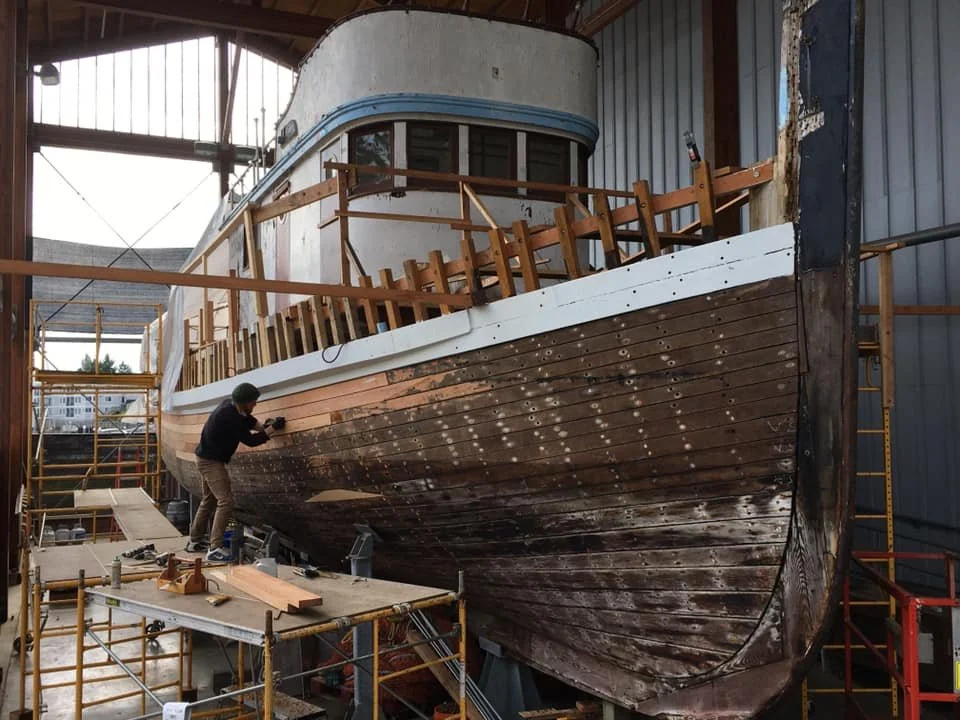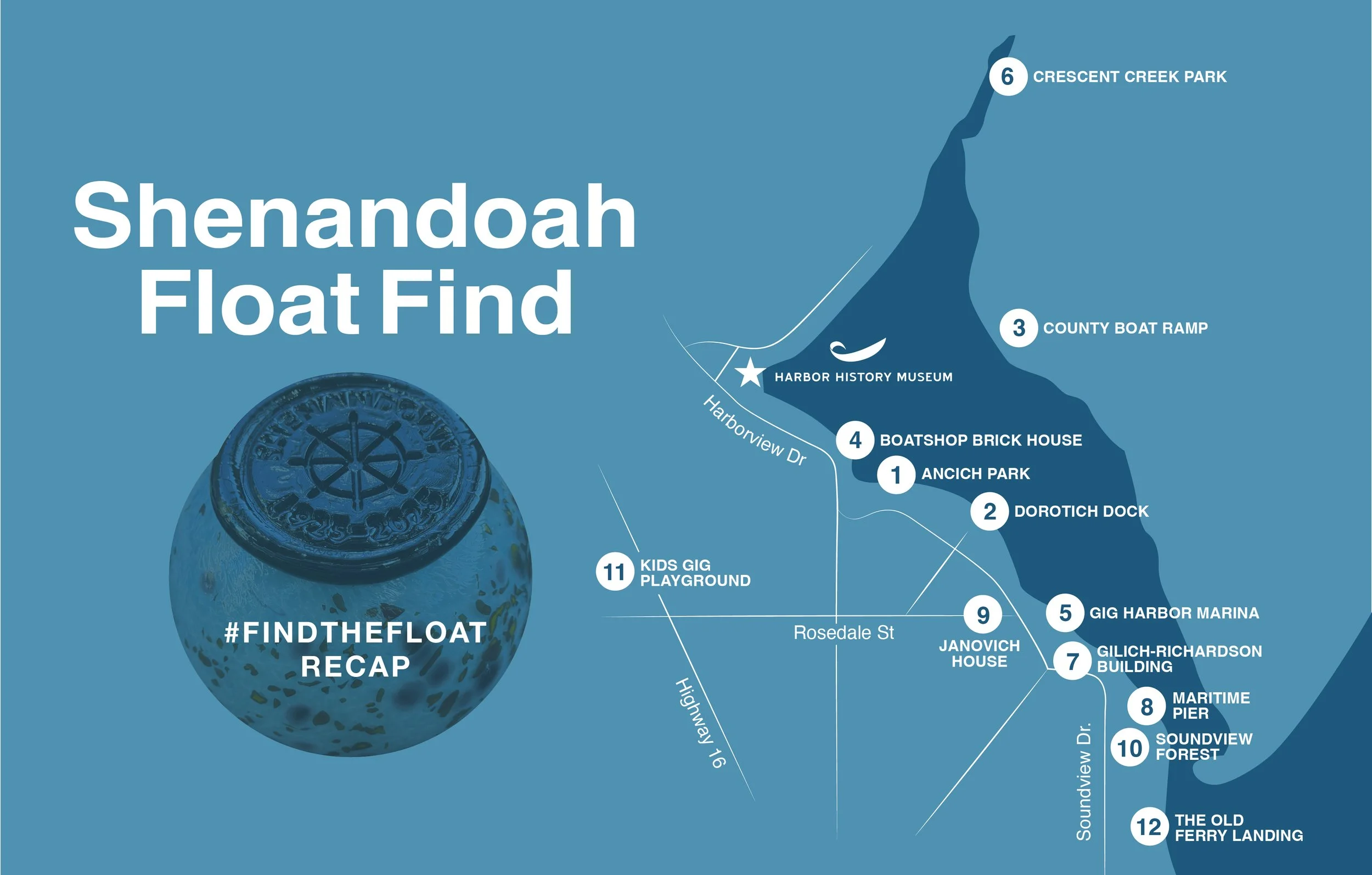


Pictures with Santa
Papa Claus is making a special stop here in the Museum gallery! Come in where it’s warm and dry to snap a picture with our beloved Santa who will meet and greet kids young and old in our special holiday history spot (sorry no pets). Admission to the museum and Santa pictures are FREE all weekend.
Spread the cheer!

Pictures with Santa
Papa Claus is making a special stop here in the Museum gallery! Come in where it’s warm and dry to snap a picture with our beloved Santa who will meet and greet kids young and old in our special holiday history spot (sorry no pets). Admission to the museum and Santa pictures are FREE all weekend.
Spread the cheer!

Gig Harbor Literary Society
The meeting will be held on Tuesday, January 6th from 6pm-7:30pm at the Harbor History Museum. The book for January is Sharks in the Time of Saviors by Kawai Strong Washburn.
In 1995 Kailua-Kona, Hawaii, on a rare family vacation, seven-year-old Nainoa Flores falls overboard a cruise ship into the Pacific Ocean. When a shiver of sharks appears in the water, everyone fears for the worst. But instead, Noa is gingerly delivered to his mother in the jaws of a shark, marking his story as the stuff of legends. Nainoa’s family, struggling amidst the collapse of the sugarcane industry, hails his rescue as a sign of favor from ancient Hawaiian gods―a belief that appears validated after he exhibits puzzling new abilities. But as time passes, this supposed divine favor begins to drive the family apart: Nainoa, working now as a paramedic on the streets of Portland, struggles to fathom the full measure of his expanding abilities; further north in Washington, his older brother Dean hurtles into the world of elite college athletics, obsessed with wealth and fame; while in California, risk-obsessed younger sister Kaui navigates an unforgiving academic workload in an attempt to forge her independence from the family’s legacy. When supernatural events revisit the Flores family in Hawai’i―with tragic consequences―they are all forced to reckon with the bonds of family, the meaning of heritage, and the cost of survival.
How to get a copy of the book:
1. Call us (253) 858-6722 at the museum and identify yourself as a Gig Harbor Literary Society member and the staff will put a copy aside for you.
2. Request an electronic version through the Libby app on your mobile device.
We look forward to hearing your thoughts. As always, even if you don't have a chance to read or listen to the book, join us. This event is FREE and open to the public. For questions, please contact Cindy Hackett at cynthia.hale.hackett@gmail.com

St. Lucia Festival
Admission is FREE for Members and $6 for Non-members.
St Lucia is a traditional favorite among Scandinavian and Italian cultures. Please join us for the annual St. Lucia Festival! Honoring the Harbor's Scandinavian roots, we will have the traditional children's procession, Swedish treats, and live singing by the GHHS choir! Join in the fun with crafts, games, storytime, and more! $6/person 5 and up, free for HHM Members.

Gig Harbor Literary Society
The meeting will be held on Wednesday, December 3rd, 6pm-7:30pm at the Harbor History Museum. The book for December is Falling From Horses by Molly Gloss.
In 1938, 19-year-old cowboy Bud Frazer sets his sights on becoming a stunt rider in the movies. Fantasizing about rubbing shoulders with the great screen cowboys of his youth, he leaves his home in Echol Creek, Oregon, and heads for Hollywood. On the long bus ride south, Bud meets a young woman who also harbors dreams of making it in the movies, though not as a starlet but as a writer, a real writer. Lily Shaw is bold and outspoken and confident in ways completely out of proportion with her small frame and bookish looks. The two proceed to strike up an unlikely kinship that will carry them through their tumultuous days in Hollywood - and, as it happens, for the rest of their lives. Acutely observed and impeccably authentic, Falling From Horses charts what turns out to be a glittering year in the movie business, seen through the wide eyes and lofty dreams of two people trying to make their mark on the world, or at least to make their way in it. As she did so memorably in her previous novel, the best-selling The Hearts of Horses, Molly Gloss weaves a remarkable tale of humans and horses, hope and heartbreak. Molly Gloss is also the author of The Jump-Off Creek, a winner of both the Pacific Northwest Booksellers Award and the Oregon Book Award, The Dazzle of Day, a New York Times Notable Book and winner of the PEN Center West Fiction Prize, and Wild Life, winner of the James Tiptree Jr. Award.
How to get a copy of the book:
1. Call us (253) 858-6722 at the museum and identify yourself as a Gig Harbor Literary Society member and the staff will put a copy aside for you.
2. Request an electronic version through the Libby app on your mobile device.
We look forward to hearing your thoughts. As always, even if you don't have a chance to read or listen to the book, join us. This event is FREE and open to the public. For questions, please contact Cindy Hackett at cynthia.hale.hackett@gmail.com


HHM Member Appreciation Day & Shop the Harbor
Double your discount at the Museum Mercantile! It’s a great day to get a jump on holiday shopping during “Shop the Harbor.” Fill your stockings with handy goods, unique Gig Harbor treasures, and sweet treats. Plus, members receive a double-discount on all mercantile goods…that’s 30% off everything from bandanas to banana slugs!

Chum Fest
Take a walk along Donkey Creek to spot any returning Chum Salmon. Along the way, pick up a passport to complete all the fun activities. Don’t miss the Museum’s new “Return of the Chum” art installation on our courtyard fence. Turn in completed passports at the museum’s front desk to be entered in a drawing to win a fun-filled Salmon Prize!

Gig Harbor Literary Society
The meeting will be held on Tuesday, November 4th from 6pm-7:30pm at the Harbor History Museum. The book for November is Red Paint: The Ancestral Autobiography of a Coast Salish Punk by Sasha LaPointe.
Sasha LaPointe has always longed for a sense of home. When she was a child, her family moved around frequently, often staying in barely habitable church attics and trailers, dangerous places for young Sasha.With little more to guide her than a passion for the thriving punk scene of the Pacific Northwest and a desire to live up to the responsibility of being the namesake of her beloved great-grandmother—a linguist who helped preserve her Indigenous language of Lushootseed—Sasha throws herself headlong into the world, determined to build a better future for herself and her people. Set against a backdrop of the breathtaking beauty of Coast Salish ancestral land and imbued with the universal spirit of punk, Red Paint is ultimately a story of the ways we learn to find our true selves while fighting for our right to claim a place of our own. Examining what it means to be vulnerable in love and in art, Sasha offers up an unblinking reckoning with personal traumas amplified by the collective historical traumas of colonialism and genocide that continue to haunt native peoples. Red Paint is an intersectional autobiography of lineage, resilience, and, above all, the ability to heal.
How to get a copy of the book:
1. Call us (253) 858-6722 at the museum and identify yourself as a Gig Harbor Literary Society member and the staff will put a copy aside for you.
2. Request an electronic version through the Libby app on your mobile device.
We look forward to hearing your thoughts. As always, even if you don't have a chance to read or listen to the book, join us. This event is FREE and open to the public. For questions, please contact Cindy Hackett at cynthia.hale.hackett@gmail.com

Buried History: Artondale Cemetery Tours
Experience the rich history of some of Gig Harbor's founding members on a guided walking tour through the historic Artondale Cemetery. Tours are offered on Sunday, October 12, and Sunday, October 19, with four tours each day. Two tours are offered at 1:30 PM and two tours are offered at 4:00 PM. Each tour is limited to 20 people. Tickets are required for every person attending, regardless of age. Please note that for the safety and comfort of all attendees, dogs are not permitted.
Tours will happen rain or shine, so dress like you live in the PNW! Warm up with complimentary hot cocoa or cider served upon check in. Your ticket purchase helps support two important local institutions, as this event is a fundraiser for both the Artondale Cemetery Association and the Harbor History Museum. Your tickets will be held at will call the day of the event. *You will not be mailed a physical ticket* Don't miss this chance to learn, remember, and contribute to the preservation of Gig Harbor's heritage!
This event is sponsored by The Far North Retreats. For further questions, please send an email to thefarnorthretreats@gmail.com Visit our website at: https://thefarnorthretreats.com/

Buried History: Artondale Cemetery Tours
Experience the rich history of some of Gig Harbor's founding members on a guided walking tour through the historic Artondale Cemetery. Tours are offered on Sunday, October 12, and Sunday, October 19, with four tours each day. Two tours are offered at 1:30 PM and two tours are offered at 4:00 PM. Each tour is limited to 20 people. Tickets are required for every person attending, regardless of age. Please note that for the safety and comfort of all attendees, dogs are not permitted.
Tours will happen rain or shine, so dress like you live in the PNW! Warm up with complimentary hot cocoa or cider served upon check in. Your ticket purchase helps support two important local institutions, as this event is a fundraiser for both the Artondale Cemetery Association and the Harbor History Museum. Your tickets will be held at will call the day of the event. *You will not be mailed a physical ticket* Don't miss this chance to learn, remember, and contribute to the preservation of Gig Harbor's heritage!
This event is sponsored by The Far North Retreats. For further questions, please send an email to thefarnorthretreats@gmail.com Visit our website at: https://thefarnorthretreats.com/

Buried History: Artondale Cemetery Tours
Experience the rich history of some of Gig Harbor's founding members on a guided walking tour through the historic Artondale Cemetery. Tours are offered on Sunday, October 12, and Sunday, October 19, with four tours each day. Two tours are offered at 1:30 PM and two tours are offered at 4:00 PM. Each tour is limited to 20 people. Tickets are required for every person attending, regardless of age. Please note that for the safety and comfort of all attendees, dogs are not permitted.
Tours will happen rain or shine, so dress like you live in the PNW! Warm up with complimentary hot cocoa or cider served upon check in. Your ticket purchase helps support two important local institutions, as this event is a fundraiser for both the Artondale Cemetery Association and the Harbor History Museum. Your tickets will be held at will call the day of the event. *You will not be mailed a physical ticket* Don't miss this chance to learn, remember, and contribute to the preservation of Gig Harbor's heritage!
This event is sponsored by The Far North Retreats. For further questions, please send an email to thefarnorthretreats@gmail.com Visit our website at: https://thefarnorthretreats.com/

Buried History: Artondale Cemetery Tours
Experience the rich history of some of Gig Harbor's founding members on a guided walking tour through the historic Artondale Cemetery. Tours are offered on Sunday, October 12, and Sunday, October 19, with four tours each day. Two tours are offered at 1:30 PM and two tours are offered at 4:00 PM. Each tour is limited to 20 people. Tickets are required for every person attending, regardless of age. Please note that for the safety and comfort of all attendees, dogs are not permitted.
Tours will happen rain or shine, so dress like you live in the PNW! Warm up with complimentary hot cocoa or cider served upon check in. Your ticket purchase helps support two important local institutions, as this event is a fundraiser for both the Artondale Cemetery Association and the Harbor History Museum. Your tickets will be held at will call the day of the event. *You will not be mailed a physical ticket* Don't miss this chance to learn, remember, and contribute to the preservation of Gig Harbor's heritage!
This event is sponsored by The Far North Retreats. For further questions, please send an email to thefarnorthretreats@gmail.com Visit our website at: https://thefarnorthretreats.com/

Gig Harbor Literary Society
The meeting will be held on Tuesday, October 7th from 6pm-7:30pm at the Harbor History Museum. The book for October is West With Giraffes by Lynda Rutledge.
An emotional, rousing novel inspired by the incredible true story of two giraffes who made headlines and won the hearts of Depression-era America. Woodrow Wilson Nickel, age 105, feels his life ebbing away. But when he learns giraffes are going extinct, he finds himself recalling the unforgettable experience he cannot take to his grave. It’s 1938. The Great Depression lingers. Hitler is threatening Europe, and world-weary Americans long for wonder. They find it in two giraffes who miraculously survive a hurricane while crossing the Atlantic. What follows is a twelve-day road trip in a custom truck to deliver Southern California’s first giraffes to the San Diego Zoo. Behind the wheel is the young Dust Bowl rowdy Woodrow. Inspired by true events, the tale weaves real-life figures with fictional ones, including the world’s first female zoo director, a crusty old man with a past, a young female photographer with a secret, and assorted reprobates as spotty as the giraffes. Part adventure, part historical saga, and part coming-of-age love story, West with Giraffes explores what it means to be changed by the grace of animals, the kindness of strangers, the passing of time, and a story told before it’s too late.
How to get a copy of the book:
1. Call us (253) 858-6722 at the museum and identify yourself as a Gig Harbor Literary Society member and the staff will put a copy aside for you.
2. Request an electronic version through the Libby app on your mobile device.
We look forward to hearing your thoughts. As always, even if you don't have a chance to read or listen to the book, join us. This event is FREE and open to the public. For questions, please contact Cindy Hackett at cynthia.hale.hackett@gmail.com

History Rocks
Join us for our annual fundraising event: History Rocks 2025: The Boom Town Twenties
Don't miss the party of the decade! Slip into your finest glad rags and step back in time to the roaring 1920s—surrounded by authentic era planes and the vibrant spirit of the Jazz Age. Enjoy both a silent and a lively in-person auction led by the incomparable Jim Borgen, savor delicious food provided by Snuffin’s Catering, and raise a glass of complimentary wine, beer, or a Boom Town Old Fashioned. Bring plenty of dough for our auctions, win prizes for the best 1920s costume, and be among the first to celebrate the Harbor History Museum’s first local history hero. It’ll be the bee’s knees!
Tickets are $100 until July 15th. After July 15th tickets will go up to $125. Attendees will be automatically registered for the event's Silent and In-Person Auctions. Purchase your tickets here!
Become a Sponsor! Your generous support will be highlighted in both our print and digital media, helping bring history to life for our entire community.
Why Your Support Matters
History Rocks isn’t just a great party—it’s a vital event that helps sustain the Harbor History Museum throughout the year. As a local non-profit museum, we rely on the generosity of friends and neighbors like you to maintain our exhibits, protect local artifacts, run educational programs, and care for our community-serving facilities. Your ticket, your bid, and your sponsorship all make a real difference in ensuring this museum remains a vibrant place of learning, discovery, and connection for generations to come.
Thank you for being part of our story.

Gig Harbor Literary Society
The meeting will be held on Tuesday, September 2nd from 6pm-7:30pm at the Harbor History Museum. The book for September is The Library Book by Susan Orlean
On the morning of April 28, 1986, a fire alarm sounded in the Los Angeles Public Library. The fire was disastrous: it reached two thousand degrees and burned for more than seven hours. By the time it was extinguished, it had consumed four hundred thousand books and damaged seven hundred thousand more. Investigators descended on the scene, but more than thirty years later, the mystery remains: Did someone purposefully set fire to the library—and if so, who? Weaving her lifelong love of books and reading into an investigation of the fire, award-winning New Yorker reporter and New York Times bestselling author Susan Orlean delivers a “delightful…reflection on the past, present, and future of libraries in America” (New York magazine) that manages to tell the broader story of libraries and librarians in a way that has never been done before. In the “exquisitely written, consistently entertaining” (The New York Times) The Library Book, Orlean chronicles the LAPL fire and its aftermath to showcase the larger, crucial role that libraries play in our lives; delves into the evolution of libraries; brings each department of the library to vivid life; studies arson and attempts to burn a copy of a book herself; and reexamines the case of Harry Peak, the blond-haired actor long suspected of setting fire to the LAPL more than thirty years ago.
“A book lover’s dream…an ambitiously researched, elegantly written book that serves as a portal into a place of history, drama, culture, and stories” (Star Tribune, Minneapolis), Susan Orlean’s thrilling journey through the stacks reveals how these beloved institutions provide much more than just books—and why they remain an essential part of the heart, mind, and soul of our country.
How to get a copy of the book:
1. Call us (253) 858-6722 at the museum and identify yourself as a Gig Harbor Literary Society member and the staff will put a copy aside for you.
2. Request an electronic version through the Libby app on your mobile device.
We look forward to hearing your thoughts. As always, even if you don't have a chance to read or listen to the book, join us. This event is FREE and open to the public. For questions, please contact Cindy Hackett at cynthia.hale.hackett@gmail.com

Rumrunning in Puget Sound with Brad Holden
Brought to you by Humanities Washington. Harbor History Museum is excited to welcome Brad Holden. When not out searching for local historical artifacts, Brad Holden enjoys writing about the more illicit side of Seattle’s past. He is a contributing writer for HistoryLink.org (an online encyclopedia of Washington state history) and his work has also appeared in Seattle Magazine and several newspapers. Holden has been profiled on KIRO and KOMO news, Seattle Refined, NPR, King 5 Evening! and various publications. His trilogy of books related to the Prohibition era are available online and at bookstores everywhere. He lives in Edmonds, WA.
For those interested in the darker corners of local history, please visit Brad's site which chronicles all the "Delinquency, Devilry & Dirty Deeds in the Pacific Northwest" - Brad Holden's Vice Files
Admission is FREE for Members and $5 for Non-members. This talk will be IN PERSON at the museum. To save your space, please RSVP to Amy Crews at finance@harborhistorymuseum.org
This event is sponsored by Mary Sudar Appraisals and Estate Sales:

Gig Harbor Literary Society
The meeting will be held on Tuesday, August 5th from 6pm-7:30pm at the Harbor History Museum. The book for August is Wives of Henry Oades by Johanna Moran.
When Henry Oades accepts an accountancy post in New Zealand, his wife, Margaret, and their children follow him to exotic Wellington. But while Henry is an adventurer, Margaret is not. Their new home is rougher and more rustic than they expected—and a single night of tragedy shatters the family when the native Maori stage an uprising, kidnapping Margaret and her children. For months, Henry scours the surrounding wilderness, until all hope is lost and his wife and children are presumed dead. Grief-stricken, he books passage to California. There he marries Nancy Foreland, a young widow with a new baby, and it seems they’ve both found happiness in the midst of their mourning—until Henry’s first wife and children show up, alive and having finally escaped captivity. Narrated primarily by the two wives, and based on a real-life legal case, The Wives of Henry Oades is the riveting story of what happens when Henry, Margaret, and Nancy face persecution for bigamy. Exploring the intricacies of marriage, the construction of family, the changing world of the late 1800s, and the strength of two remarkable women, Johanna Moran turns this unusual family’s story into an unforgettable page-turning drama.
How to get a copy of the book:
1. Call us (253) 858-6722 at the museum and identify yourself as a Gig Harbor Literary Society member and the staff will put a copy aside for you.
2. Request an electronic version through the Libby app on your mobile device.
We look forward to hearing your thoughts. As always, even if you don't have a chance to read or listen to the book, join us. This event is FREE and open to the public. For questions, please contact Cindy Hackett at cynthia.hale.hackett@gmail.com

True Tales of True Crime with Author Anne Jeager
This event is at capacity, but we hope to see you next time. Thanks for your interest!
**************************************************
Join us for a Special Presentation with Author and Portland TV Personality Anne Jaeger
Discover stories behind The Rule of Crime and Me, the compelling new biography of America’s legendary true crime author, Ann Rule.
Anne Jaeger; longtime journalist, crime reporter, and friend of Ann Rule, shares insights from their remarkable 31-year friendship. In this special event, Jaeger will reveal behind-the-scenes moments, personal anecdotes, and surprising adventures they experienced together, including encounters with some of the same notorious criminals, such as Diane Downs.
Don’t miss this unique opportunity to hear from someone who knew the Queen of True Crime best.
This is a partnered event with West Sound Crime Con.

Journey from Old World to New: The Shenandoah's Croatian Roots
The Dorotich, Skansie, Kazulin, Gilich, Bez, and Janovich families all came from Croatia, and more specifically the Dalmatian coast and the island of Brac. All were connected to the FV Shenandoah. But how did they find their way to America, and how were they related? Join director Stephanie Lile for a journey to and from the Austro-Hungarian Empire to America and discover the complex ties to each other and the Shenandoah. Learn more about our Croatian sister city, cross-continental boat building projects, and the invention that changed the face of commercial fishing forever.
Admission is FREE for Members and $5 for Non-members. This talk will be IN PERSON at the museum. To save your space, please RSVP to Amy Crews at finance@harborhistorymuseum.org

Peninsula Light Centennial Celebration
PenLight’s 100-Year Anniversary Event: Community Centennial Celebration
Join us on July 14, 2025, as we celebrate PenLight’s 100th birthday with a day full of community fun and history at the Harbor History Museum! From 1–4 PM, enjoy a family-friendly event hosted by PenLight employees including STEM activities, demonstrations, treats and more! Then, from 5–6 PM, gather for a Centennial Ceremonial Celebration to honor PenLight’s legacy and look ahead to the future. Don’t miss this milestone moment in our community’s history!

Gig Harbor Literary Society
The meeting will be held on Tuesday, July 1st from 6pm-7:30pm at the Harbor History Museum.
The book for July is Educated by Tara Westover.
Born to survivalists in the mountains of Idaho, Tara Westover was seventeen the first time she set foot in a classroom. Her family was so isolated from mainstream society that there was no one to ensure the children received an education, and no one to intervene when one of Tara’s older brothers became violent. When another brother got himself into college, Tara decided to try a new kind of life. Her quest for knowledge transformed her, taking her over oceans and across continents, to Harvard and to Cambridge University. Only then would she wonder if she’d traveled too far, if there was still a way home.
“Beautiful and propulsive . . . Despite the singularity of [Westover’s] childhood, the questions her book poses are universal: How much of ourselves should we give to those we love? And how much must we betray them to grow up?”—Vogue
You can get a copy of the book in one of several ways:
1. Call us (253) 858-6722 at the museum and identify yourself as a Gig Harbor Literary Society member and the staff will put a copy aside for you. Copies available starting June 3.
2. Request an electronic version through the Libby app on your mobile device.
We look forward to hearing your thoughts. As always, even if you don't have a chance to read or listen to the book, join us. This event is FREE and open to the public. For questions, please contact Cindy Hackett at cynthia.hale.hackett@gmail.com

Heaven on the Half Shell: Washington State's Oyster Odyssey
Gordon’s popular titles—Sasquatch Seeker’s Field Manual, Heaven on the Half Shell, and The Eat-a-Bug Cookbook—will be available for purchase at the event. Don’t miss the chance to have your new book personally signed by Gordon! Please note: Payment accepted by cash or check only.
Brought to you by Humanities Washington. Harbor History Museum is excited to welcome David George Gordon, author and journalist.
David George Gordon (he/him) is the principle author of Heaven on the Half Shell: The Story of the Oyster in the Pacific Northwest. This includes Native American sea gardens, the cultivation of various oyster species, and the innovations that have made oysters a sustainable food source. The story delves into the Olympia oyster, Eastern oyster, and Pacific oyster, highlighting their role in the Pacific Northwest's culinary landscape and the efforts to protect and cultivate them. The book also explores the history of oyster farming and harvesting in Washington, including the impact on the environment and the people who depend on it.
A former science writer for Washington Sea Grant, Gordon has written 22 books on topics ranging from slugs and snails to sharks, gray whales, and Sasquatch.
Admission is FREE thanks to Humanities Washington! Humanities Washington sparks conversation and critical thinking using story as a catalyst, nurturing thoughtful and engaged communities across our state. This talk will be IN PERSON at the museum. To save your space, please RSVP to Amy Crews at finance@harborhistorymuseum.org

Gig Harbor Literary Society
The meeting will be held on Tuesday, June 3rd from 6pm-7:30pm at the Harbor History Museum.
The book for June is North Woods by Daniel Mason
When two young lovers abscond from a Puritan colony, little do they know that their humble cabin in the woods will become the home of an extraordinary succession of human and nonhuman characters alike. An English soldier, destined for glory, abandons the battlefields of the New World to devote himself to growing apples. A pair of spinster twins navigate war and famine, envy and desire. A crime reporter unearths an ancient mass grave—only to discover that the earth refuse to give up their secrets. A lovelorn painter, a sinister con man, a stalking panther, a lusty beetle: As the inhabitants confront the wonder and mystery around them, they begin to realize that the dark, raucous, beautiful past is very much alive.
This magisterial and highly inventive novel from Pulitzer Prize finalist Daniel Mason brims with love and madness, humor and hope. Following the cycles of history, nature, and even language, North Woods shows the myriad, magical ways in which we’re connected to our environment, to history, and to one another. It is not just an unforgettable novel about secrets and destinies, but a way of looking at the world that asks the timeless question: How do we live on, even after we’re gone?
You can get a copy of the book in one of several ways:
1. Call us (253) 858-6722 at the museum and identify yourself as a Gig Harbor Literary Society member and the staff will put a copy aside for you. Copies will be available starting May 6th.
2. Request an electronic version through the Libby app on your mobile device.
We look forward to hearing your thoughts. As always, even if you don't have a chance to read or listen to the book, join us. This event is FREE and open to the public. For questions, please contact Cindy Hackett at cynthia.hale.hackett@gmail.com

Women on Board: Stories from Gig Harbor’s Trailblazing Fisherwomen
This event has reached capacity as of 5/28.
Until the 1970s, women on board fishing boats were virtually unheard of. Superstitions held that women brought bad luck, caused unrest among the crew, and were generally not capable of working the long days on board. A handful of young Gig Harbor women changed all that. Some worked their fathers’ boats, others worked alongside their husbands. Still others broke the mold and ran their own boats. The Shenandoah at the Harbor History Museum was one boat where women defied superstition and worked on board, but it wasn’t always easy.
Join us for a lively discussion with three Gig Harbor women fishers who were the ground breakers of their time. Bunky Janovich crewed on board the Shenandoah. Laurie Dahl Isacson worked as cook and crew on the Pacific Maid, and Debbi Ross worked on both a purse seiner and a halibut long liner. Their stories of life on board will surprise and amaze!
Admission is FREE for Members and $5 Non-Members. This talk will be IN PERSON at the museum. To save your space, please RSVP to Amy Crews at finance@harborhistorymuseum.org

Orca Night
Hosted by South Sound Surfrider
Join us for a special screening of Echos of the Sound, an award-winning documentary by sister filmmakers Emma & Annie Stafki of Two Girls Take on the World. Plus a live reading by children’s author Sharon Mentyka, featuring her orca-themed novel Chasing at the Surface.

Gig Harbor Literary Society
The meeting will be held on Tuesday, May 6th from 6pm-7:30pm at the Harbor History Museum.
The book for May is The Snow Child by Eowyn Ivey.
In this magical debut, a couple's lives are changed forever by the arrival of a little girl, wild and secretive, on their snowy doorstep.
Alaska, 1920: a brutal place to homestead, and especially tough for recent arrivals Jack and Mabel. Childless, they are drifting apart - he breaking under the weight of the work of the farm; she crumbling from loneliness and despair. In a moment of levity during the season's first snowfall, they build a child out of snow. The next morning the snow child is gone - but they glimpse a young, blonde-haired girl running through the trees.
This little girl, who calls herself Faina, seems to be a child of the woods. She hunts with a red fox at her side, skims lightly across the snow, and somehow survives alone in the Alaskan wilderness. As Jack and Mabel struggle to understand this child who could have stepped from the pages of a fairy tale, they come to love her as their own daughter. But in this beautiful, violent place things are rarely as they appear, and what they eventually learn about Faina will transform all of them.
You can get a copy of the book in one of several ways:
1. Call us (253) 858-6722 at the museum and identify yourself as a Gig Harbor Literary Society member and the staff will put a copy aside for you.
2. Request an electronic version through the Libby app on your mobile device.
We look forward to hearing your thoughts. As always, even if you don't have a chance to read or listen to the book, join us. This event is FREE and open to the public. For questions, please contact Cindy Hackett at cynthia.hale.hackett@gmail.com

Maritime Gallery Grand Opening
Join us for the grand opening of Harbor History Museum’s Maritime Gallery! Celebrate 100 years of the Shenandoah; our 65’ purse seiner fishing vessel, and the completion of its remarkable restoration. See Thunderbird #1, the inspiration for an international fleet and racing class, and numerous small craft that represent Gig Harbor’s boat building heritage. Enjoy local food vendors, lively maritime music, insider history scoop talks, blacksmith demonstration, ribbon cutting ceremony, boat tours, and fun activities for all ages. Don’t miss this exciting day of community and celebration as we honor Gig Harbor’s maritime heritage together. Admission is free.
A special thanks to our wonderful donors and sponsors who have believed in this project over the years. It’s nearly done, thanks to you!
Still interested in supporting this project or the community opening through a donation or sponsorship? Donate Today

Scarfs, Bungs, and Big Knees: Tales of the Shenandoah Restoration
The Harbor History Museum is excited to announce a special presentation from our very own Shipwright, Riley Hall, on the restoration of the Shenandoah as a part of our Humanities in the Harbor Series.
Admission is FREE.
This talk will be IN PERSON at the museum. To save your space, please RSVP to Stephanie Lile at director@harborhistorymuseum.org

Gig Harbor Literary Society
The meeting will be held on Tuesday, March 4th at 6:00 pm at the Harbor History Museum. The book for our March meeting is The Wager: A Tale of Shipwreck, Mutiny and Murder by David Grann.
---------------------------------------------------------
On January 28, 1742, a ramshackle vessel of patched-together wood and cloth washed up on the coast of Brazil. Inside were thirty emaciated men, barely alive, and they had an extraordinary tale to tell. They were survivors of His Majesty’s Ship the Wager, a British vessel that had left England in 1740 on a secret mission during an imperial war with Spain. While the Wager had been chasing a Spanish treasure-filled galleon known as “the prize of all the oceans,” it had wrecked on a desolate island off the coast of Patagonia. The men, after being marooned for months and facing starvation, built the flimsy craft and sailed for more than a hundred days, traversing nearly 3,000 miles of storm-wracked seas. They were greeted as heroes.
But then ... six months later, another, even more decrepit craft landed on the coast of Chile. This boat contained just three castaways, and they told a very different story. The thirty sailors who landed in Brazil were not heroes – they were mutineers. The first group responded with countercharges of their own, of a tyrannical and murderous senior officer and his henchmen. It became clear that while stranded on the island the crew had fallen into anarchy, with warring factions fighting for dominion over the barren wilderness. As accusations of treachery and murder flew, the Admiralty convened a court martial to determine who was telling the truth. The stakes were life-and-death—for whomever the court found guilty could hang.
The Wager is a grand tale of human behavior at the extremes told by one of our greatest nonfiction writers. Grann’s recreation of the hidden world on a British warship rivals the work of Patrick O’Brian, his portrayal of the castaways’ desperate straits stands up to the classics of survival writing such as The Endurance, and his account of the court martial has the savvy of a Scott Turow thriller. As always with Grann’s work, the incredible twists of the narrative hold the reader spellbound.
You can get a copy of the book in one of several ways:
1. Call us (253) 858-6722 at the museum and identify yourself as a Gig Harbor Literary Society member and the staff will put a copy aside for you.
2. Request an electronic version through the Libby app on your mobile device.
We look forward to hearing your thoughts. As always, even if you don't have a chance to read or listen to the book, join us.
----------------------------------
This event is FREE and open to the public. For questions, please contact Cindy Hackett at cynthia.hale.hackett@gmail.com

Shenandoah Float Find
Here is a recap of our Float Find, thank you to all who participated! Stay tuned for updates on an upcoming float auction to benefit Harbor History Museum. A very limited number of medallions are available in the Harbor History Museum Mercantile.
The Harbor History Museum has partnered with Hilltop Artists to create a set of unique Shenandoah glass floats. From now until the end of April, just one Shenandoah float will be hidden each week until the Grand Opening of the Maritime Gallery on April 26.
WEEK 1 - Ancich Dock: For many years during the Shenandoah's fishing days, she was moored at Ancich Dock, often alongside Andrew Gilich’s boat St. Mary. From 1967 to 2000, Shenandoah was owned and run by the Tony Janovich family. They primarily fished in the San Juans during the summer and various locations around the Sound in the fall.
WEEK 2 – Location: End of Dorotich Street on Dock: Pasco and Matija Dorotich and their two children, John and Lena, came to Gig Harbor from Port Guchion in British Columbia around 1910. Both had been born in Sumartin, Croatia (then Austria). The family lived in the house at 3400 Harborview until John's death in 1966. Pasco was the first skipper of the Shenandoah, then passed that job on to his son in 1943. Note: Gig Harbor actually had two Dorotich families; the Pasco and Matija (Gilich) family and the Joseph and Caroline (Jerisich) family. Both families had a son named John. Both Johns were boat captains—one of a fishing boat, the other of a ferry. Joseph Dorotich also had roots in Sumartin (St. Martin).
WEEK 3 - County boat ramp: In 2003, Shenandoah was hauled out at the county boat ramp and paraded through town. Even though her mast had been removed, telephone and electrical wires had to be moved in order for her to pass. The boat made her way to the property above Donkey Creek Park then owned by the Historical Society/Museum. It was in this location that Shenandoah was documented for the Historic Architectural and Engineering Record by the National Park Service. Her plans and images can be found online at the Library of Congress.
WEEK 4 - Gig Harbor BoatShop Brick House, with a view of the outside ways: In 1949, Shenandoah had a makeover. She was hauled out on the ways to have her original small cabin rebuilt at the then Glein Boatyard by talented shipwrights Nels Stokke and Hugh Denny. A new deckhouse was a new life, and skipper John Dorotich loved his boat. The deckhouse gave him and his crew a new galley and a place to gather. It gave him a cozy bunk and pilot house with windows that could be opened on warm days and closed against angry weather.
WEEK 5 - Gig Harbor Marina – Formerly Skansie’s Ship Yard: Float #5 was placed overlooking the birthplace of the FV Shenandoah. Constructed here in 1925 under the boat building prowess of Mitchell Skansie and shop foreman Sam Kazulin, the Shenandoah was built for Pasco Dorotich and his son John. Born with fishing in their blood, Pasco skippered the boat until 1943, and John until 1966. Pasco and his wife Matija Gilich Dorotich were originally from the Island of Brac in what is now Croatia.
WEEK 6 - Crescent Creek Park – Among the salmon: Catching and hauling salmon was the Shenandoah’s job. Abundant salmon runs have been central to the success of Gig Harbor’s fishing fleet for generations. This week’s float was hidden amidst the abundant Northwest underwater world of carver Jeff Samudosky’s incredible carving at Crescent Creek Park. It reminds us how important the care of the ocean and management of the fisheries are to the life cycle of the salmon.
Gig Harbor has two salmon creeks; Crescent Creek and the other known as Donkey Creek or North Creek. Shenandoah was built to catch and carry salmon, but every fisherman knows it’s essential for salmon to return to their rivers and creeks to spawn. Without safe and unpolluted spawning grounds, Northwest salmon will disappear forever. The biggest haul Shenandoah ever made in the Janovich years was 8600 Sockeye caught off the shores of San Juan island!
Week 7 - Gilich – Richardson Building: This week’s float was hidden in front of the 1924-25 Gilich-Richardson Building, pride and joy of our little bitty Boom Town! Andria Gilich had a dream to build a hotel, café, and office space, so he partnered with Richardson, and build it they did. The building was bustling with the new Peninsula Hotel, the Peninsula Café where Mrs. Theil served her famous pie, and even baths could be had for a mere 25 cents.
You might be wondering what the Shenandoah connection is. Well, it turns out that Matjia Dorotich’s maiden name was “Gilich” and Andria (Anglified as “Andrew”) Gilich was her half-brother. They both immigrated to Vancouver B.C. in their teens where Andria became a fishing boat skipper at 17. He immigrated to America/Gig Harbor in 1905. Matija married Pasco Dorotich while in Canada, and the couple later followed Andrew to Gig Harbor. Gilich’s fishing boat St. Mary fished with and was often moored next to Shenandoah at the nearby Union Oil dock. Find out more in our new exhibit, “Little Bitty Boom Town: Gig Harbor in the 1920s.”
WEEK 8 – Maritime Pier: In the 1920s, this spot was known as People’s Wharf. Ferries came and went. West Coast Grocery occupied the building we know today as the Tides. The new Washington Egg & Poultry Co-op warehouse was right next door. Here, wives watched for their husbands to return from fishing. Neighbors stopped to chat and shop for groceries. Many families shared a common language, having come from the Dalmatian Coast in what is now Croatia. Pasco and Matija learned early on that they were the second Dorotich Family in Gig Harbor. The first was Joseph and Caroline (Jerisich) Dorotich who had eight children, including a son named John. (Yes, there were TWO John Dorotichs in town, one skippered the Shenandoah, the other was a skipper on the Skansonia ferry). The Shenandoah was moored here, in this general location, in the 1950s-60s (possibly earlier), when it was Union Dock.
These two images give a good sense of what Gig Harbor looked like in the 1920s: West Side Grocery with the steamer FLORENCE moored at the dock; and a wider view of fishing boats moored in Gig Harbor in 1926. There is a fishing boat at the dock right near this location. Could it be Shenandoah? Or was she one of the boats moored beyond the low-tide line? We may never know. A big thanks to the Northwest Room at Tacoma Public Library for preserving these rarely seen views.
WEEK 9 - Janovich house on Rosedale Street: One of the classic historic houses in Gig Harbor, the Janovich House was built in 1927. It was home to the Spiro Janovich Family until 2015. Like Pasco Dorotich, Spiro had immigrated to America from the island of Brac along the Dalmatian Coast. He had served in the Austrian navy and readily took to the local commercial fishing trade. He married Katherine Parcich in 1925 and they settled in Gig Harbor. Spiro and Katherine had two sons, Anthony (Tony) and George. The boys grew up in this house, running down the hill to the dock until they were old enough to go fishing on the first family boat, the Monitor. Tony was just 22 when he took over as skipper on the Monitor.
Tony inherited the house after his parents passed, raising his own family there. When asked about buying the Shenandoah in 1967, he said, “The timing was perfect, and I was very proud to be the owner of a boat that I had known so well since I was just a kid. The Shenandoah and I were both born the same year in the same town.”
Tony Janovich donated the Shenandoah to the Harbor History Museum in 2000. He passed later that year at the age of 74. He’d lived his whole life in this house.
WEEK 10 – Soundview Forest: You might wonder what a forest and the Shenandoah have in common? If you guessed local wood, you’re right. The Shenandoah was built primarily with Douglas fir. Fir was used for planking, longitudinal stringers, decking and more. Other woods used in her original construction and restoration include white oak for frames, yellow cedar for the deckhouse framing, plywood for deckhouse facing, and ironwood/ipe for bulwark caps.
The big stump where the float was hidden is the remainder of a nearly 200-year-old fir. Trees like this were harvested extensively throughout the area, milled in local sawmills, and used for building boats, homes, and even local roads
WEEK 11 – Shenandoah at the Kids Gig Playground: The Kid’s Gig has been a longtime favorite spot for kids to climb and play. Built through a community fundraising and construction effort led by Kathy Hall and Laura Meacham, the Kids’ Gig has stood the test of time, and for many, is the first introduction to local history. There’s the Roxy Theater (featured in our current special exhibition Little Bitty Boom Town), a Gig (as in the one used by the Wilkes Expedition to chart Gig Harbor), and yes, a fishing boat called Shenandoah (after our very own). The Kids Gig is located behind Discovery Elementary School and is open to the public during non-school hours.
We want to pause here to extend a BIG THANK YOU to everyone who has been dedicated to the Shenandoah Float Find. It’s been an extraordinary experience to see so many involved in the “hunt.” In honor of those efforts, we have a surprise coming next week, so follow us on FaceBook and Instagram to get the news of the last float find and Grand Opening of the Maritime Gallery.
WEEK 12 – The Old Ferry Landing: The last Shenandoah float was hidden at a unique vantage point of Gig Harbor. Known as “the old ferry landing,” this week’s float find is dedicated to Mattie Dorotich, one of the many women who stood watch at the mouth of the harbor waiting for their husbands’ boats to arrive back in the harbor from fishing. She was originally from Sumartin (often called St. Martin) on the isle of Brac, but immigrated to the Vancouver, B.C. area as a teen, along with her 17-year-old half brother Andrew Gilich. She eventually married Pasco Dorotich while still in Canada and they moved to Gig Harbor just before 1910.
On the bluff above this site was once the home of Peter Skansi, the oldest of the four Skansie brothers. He was instrumental in bringing his younger brothers to Gig Harbor from their hometown in what was then the Austro-Hungarian Empire.
Medallions were hidden at the shoreline of Bogue park, at the Fishermen’s Memorial, in the Little Midway Library, near the Shenandoah paver at Ancich Park, and in Austin Park. A big thanks to all float seekers and finders for an amazing 12 weeks of celebrating the Shenandoah’s deep roots in Gig Harbor’s history.
Float Seeker’s Guidelines:
Each location is a public spot, so there’s no need to rummage through people’s yards, cross into dangerous territory, or trespass.
Each location has something to do with the Shenandoah’s story. These tidbits will be shared once the float in that location has been found.
If you are lucky enough to find a float, make sure to let us know by posting a picture of the float where you found it on our Facebook page or tagging Harbor History Museum on Instagram. And yes, it is yours to keep or share as you wish.
There are just 12 floats, one for each week leading up to the grand opening of the new Maritime Gallery. If you are lucky enough to find more than one during the float hunt, please consider leaving it for someone else to find since there are so few.
Be kind to other float seekers. Be careful and respectful of other people’s property. Have fun and join the journey of revealing the Shenandoah story. We’ll post more info each week, so everyone can join the fun!

How To Write A Family Portrait -- Workshop
Brought to you by Humanities Washington. Harbor History Museum is excited to welcome author Kristen Millares Young to our museum for workshop on how to write a family portrait.
Tell the stories that have preoccupied, amused, and defined your family for generations.
In this hour-long generative writing workshop, essayist Kristen Millares Young will use guided prompts and discussions to help you plan, write, and revise your family stories. By reflecting on intimate truths, we can redefine how we think about ourselves and our kin, contribute to our communities, and spark vital conversations.
This workshop is offered in both English and Spanish. Participants will leave with new pages.
Cuente las historias que han preocupado, divertido y definido a su familia por generaciones.
En este taller de escritura generativa de una hora de duración, la ensayista Kristen Millares Young utilizará sugerencias guiadas y discusiones para ayudarle a planificar, escribir y revisar sus historias familiares. Al reflexionar sobre algunas verdades íntimas, podemos redefinir como pensamos acerca de nosotros mismos y nuestros familiares, contribuir a nuestras comunidades y generar conversaciones vitales.
Este taller será ofrecido en inglés y en español. Los participantes saldrán con una nueva perspectiva.
Kristen Millares Young is a journalist, essayist, and author. Her novel Subduction was a winner of the Nautilus and IPPY awards, as well as a finalist for two International Latino Book Awards and Foreword Indies Book of the Year. She is also the editor of Seismic. Millares Young was the researcher for the New York Times team behind “Snow Fall,” which won a Pulitzer. Her essays, reviews, and investigations appear in the Washington Post, the Guardian, and anthologies such as Alone Together.
Humanities in the Harbor is held at Harbor History Museum, 4121 Harborview Drive, Gig Harbor, WA 98332. Admission is FREE thanks to Humanities Washington! Humanities Washington sparks conversation and critical thinking using story as a catalyst, nurturing thoughtful and engaged communities across our state.
This talk will be IN PERSON at the museum. To save your space, please RSVP to Amy Crews at Harbor History Museum at finance@harborhistorymuseum.org

Gig Harbor Literary Society
The meeting will be held on Tuesday, February 4th at 6:00 pm at the Harbor History Museum. For our February meeting all attending are asked to bring a book they have enjoyed and do a short talk including a summary and why you would recommend it. We challenge our participants to find a book that relates to the PNW connected by author, theme, setting, character etc. but is not a requirement.
Newcomers are always welcome as well as people who haven’t had a chance to read something they would like to share.
This event is FREE and open to the public. For questions, please contact Cindy Hackett at cynthia.hale.hackett@gmail.com

































